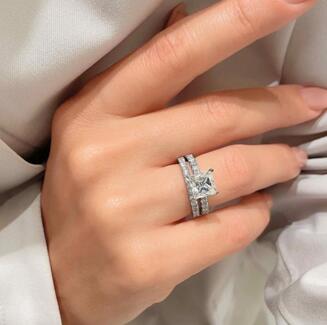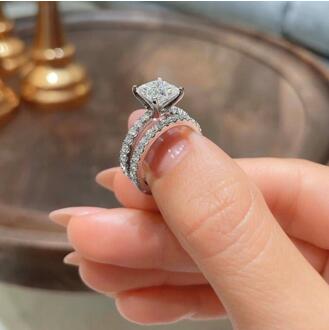Deciding on jewelry that symbolizes the journey of love is a moment filled with joy and anticipation. Among these cherished pieces are engagement rings and wedding rings, each carrying a unique meaning and tradition. As couples prepare to take their vows, understanding the engagement ring vs wedding ring becomes a part of the journey. This article will explain these symbols of love and give insights into how they are worn, preparing you for this beautiful commitment. Let's get started!

An engagement ring is a piece of jewelry traditionally given during a proposal or shortly after, signifying the intent to marry. It's often embellished with diamonds or other precious stones and features intricate designs that reflect the wearer's style and the giver's affection. The ring is worn on the left hand's fourth finger (ring finger) based on the ancient belief/myth that a vein in this finger leads directly to one's heart, symbolizing love and commitment in many Western cultures.
A wedding ring is exchanged between partners/couples during the wedding rite and represents the official bond of marriage. These rings are usually crafted to be worn together with the engagement ring but tend to have a more straightforward and timeless design that emphasizes endurance and the unbroken circle of love. Wedding rings are typically made of a resistant metal like gold, platinum, or silver, often without the large gemstones that characterize engagement rings.
Understanding the difference between an engagement ring vs a wedding ring is essential for appreciating their unique roles in the journey from engagement to marriage. Each ring serves a different purpose and carries its own symbolism and traditions.
An engagement ring is given during a proposal to signify the intention to marry. This ring symbolizes a promise and the commitment to a future marriage, marking the beginning of the engagement period. On the other hand, a wedding ring is exchanged during the wedding ceremony itself. It symbolizes the actual union and the lifelong commitment made on the wedding day, representing the formalization of the couple's relationship.
Engagement rings are typically more elaborate, featuring a central gemstone, usually a diamond, often surrounded by smaller stones or set in an intricate band. This design highlights the importance and significance of the proposal. In contrast, wedding rings are usually simpler in design. They often consist of a plain metal band without a central gemstone, focusing on a more understated and timeless look. However, they can still feature small diamonds or other decorations to complement the engagement ring.
Traditionally, the engagement ring is worn on the fourth finger of the left hand from the time of the proposal until the wedding day. During the wedding ceremony, the wedding ring is placed on the same finger. It is often worn together with the engagement ring post-ceremony, although some choose to wear the wedding ring alone. This tradition symbolizes the transition from engagement to marriage.
Engagement rings are generally more expensive due to the presence of a central gemstone like a diamond. They are considered significant investments and often involve careful selection and considerable expense. Wedding rings, on the other hand, are typically less costly as they tend to be simpler. The focus is on the quality of the metal and any minor embellishments, making them more affordable but equally significant.
The tradition of proposing with an engagement ring is widely recognized and celebrated across many cultures, though styles and customs may vary. This practice is often accompanied by romantic gestures and is a well-anticipated event. The exchange of wedding rings, however, is a universal practice in wedding ceremonies, symbolizing the official commencement of marriage. It is a deeply ingrained tradition that spans various cultures and religious practices.
The decision to have both an engagement ring and a wedding ring depends on personal preference and cultural traditions.
Some people choose to have both rings as symbols of love and commitment at different stages of the wedding process. They see the engagement ring as a token of the proposal and the wedding band as a sign of the marriage bond. Others may opt for a single ring to serve both purposes. This choice can be influenced mainly by financial considerations, lifestyle, or a preference for minimalism.
Ultimately, whether to have both rings or a single piece that represents both the engagement and marriage is a decision that partners should make together, ensuring it aligns with their values, tastes, and the story they want to tell through their jewelry.

Before the wedding, the engagement ring is conventionally worn on the fourth finger of the left hand, symbolizing the promise of marriage. During the wedding rite, the engagement ring is usually moved to the right hand to make way for the wedding band, which symbolizes eternal love and commitment. The wedding band is then placed on the left hand, closer to the heart, to emphasize its significance in representing the marital oath.
After getting married, most people choose to wear both their engagement and wedding jewelry rings together on the left ring finger, with the wedding band placed first. This arrangement emphasizes the direct connection of the wedding band to the heart and its representation of enduring commitment, while the engagement ring symbolizes the initial promise. In addition, many people opt for bridal sets or even solder their rings together for a unified look.
Despite all this, how you choose to wear your engagement and wedding bands is a personal decision that reflects your unique relationship and the love it signifies.
In conclusion, understanding the distinctions between an engagement ring vs wedding ring enhances the personal significance of these symbols. While each represents different chapters in the story of love, knowing their importance and how they can be worn together allows couples to express their commitment in a way that best reflects their unique bond. By making wise decisions that honor these traditions, couples can ensure that these precious symbols resonate with personal meaning and joy for years to come.
Yes, you can definitely use your engagement ring as your wedding ring. Many people choose to do this for a variety of reasons including sentimental value, financial considerations, or simply a preference for the style of their engagement ring. It’s a personal choice that reflects the unique relationship and values of the couple.
If you decide to go this route, some opt to add a special touch to the engagement ring on the wedding day, such as an engrave or an additional band, to signify its new significance as a wedding ring.
Typically, the engagement ring is considered to be fancier than the wedding ring. Engagement rings often feature a prominent gemstone, such as a diamond, and are designed to be eye-catching and symbolize the promise of marriage. In contrast, wedding bands are usually more understated and are worn by both partners to signify their marital status. The simplicity of wedding bands makes them more suited for daily wear and symbolically represents the enduring nature of the marriage commitment.
Traditionally, only one partner, typically the bride-to-be, wears an engagement ring. However, contemporary practices vary widely, and it's becoming increasingly common for both partners/couples to wear engagement rings if they choose. This shift reflects a broader and inclusive trend towards equality and personalization in relationships, where couples decide what is meaningful and preferable to them rather than strictly adhering to traditional norms.
When can I change my nose piercing safely? Get safe tips on the right timing for swapping your nose ring and ensuring proper aftercare for a quick heal.
Read MoreWhy is my white gold ring turning yellow? Find out why it happens and get expert tips on fixing and preventing it, ensuring lasting shine. Read on for more!
Read MoreCan sterling silver turn your finger green? Learn the mechanism behind it, how to prevent it, and what to do once it happens. Read on for the answers!
Read MoreWhy do rings turn your finger green? Find out the reasons behind this phenomenon, and how to fix and prevent the green discoloration caused by certain jewelry.
Read More